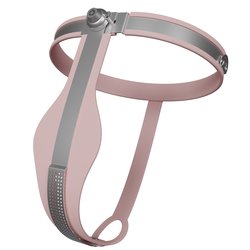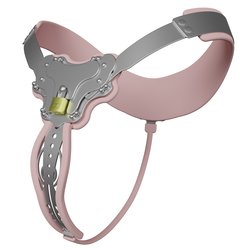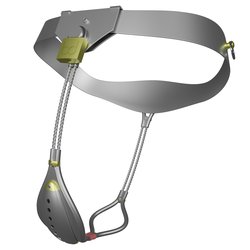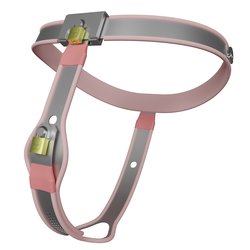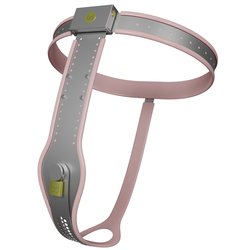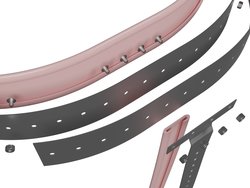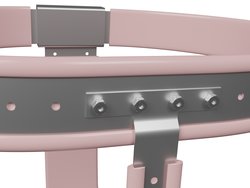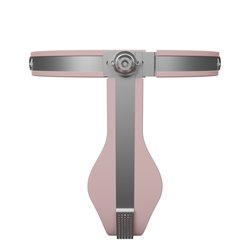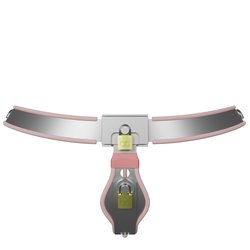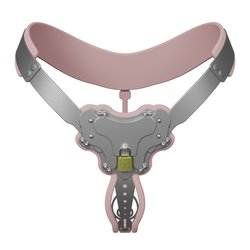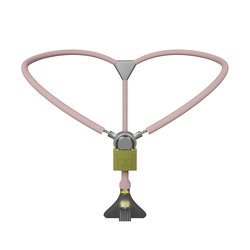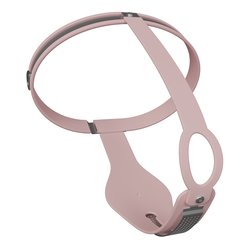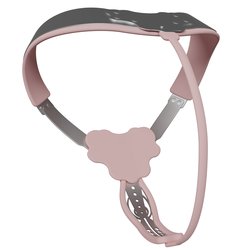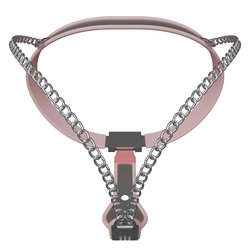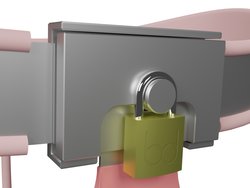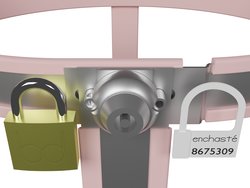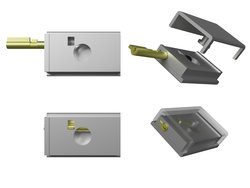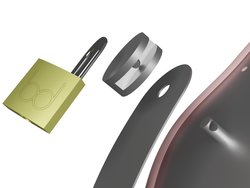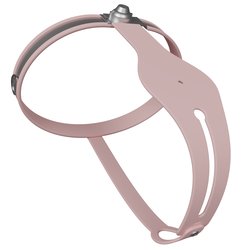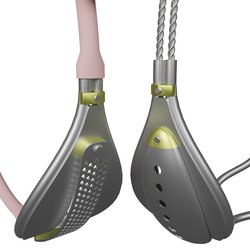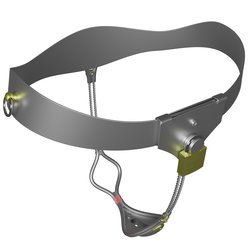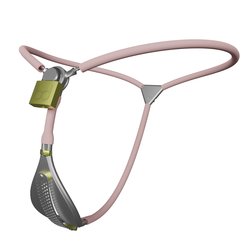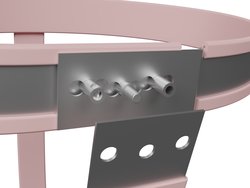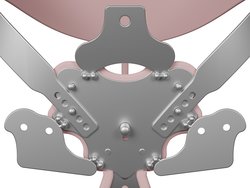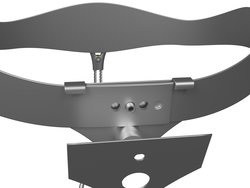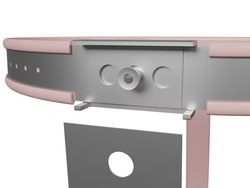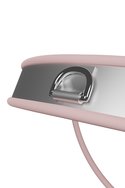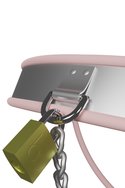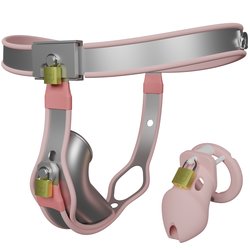What's the difference between mass-produced and custom-made chastity belts?
If you were to go back a decade or two, you'd find that metal chastity belts were an extremely niche product, manufactured by a small number of craftsmen whose names still command respect today. These skilled metalsmiths put their hearts into creating what were often works of art, not only using the highest quality materials but calling upon years of experience to produce belts that could be immediately recognised as theirs. Needless to say, such excellence came at a price, with the steep cost of custom-made steel often accompanied by a significant waiting list for the work of what might be one or two men in a workshop.
Some of the old names still survive to this day, others having been replaced by relative newcomers in various stages of proving their reputations - Figure 2.1 shows a range of contemporary designs. The biggest change to the market, however, has been the advent of much cheaper Chinese chastity belts, such as that illustrated in Figure 2.2, mass-produced affairs that, like many imitation products, tend to cut corners both in terms of materials and design. Not only is their steel and silicone thinner and of lower grade, but the parts fasten less precisely, with less care being taken to ensure that the end result actually serves the intended purpose. The difference is comparable to that between a fast food and a five star restaurant, but even those with bottomless pockets might fill their stomachs at the former to tide them over until they can dine more luxuriously.
Although you might still have to wait for a mass-produced chastity belt to come to you from halfway around the world, you can obtain one for a fraction of the cost of a custom-made offering if you're willing to lower your standards. The biggest advantage that the Chinese belts have, however, is their adjustable design (Figure 2.3), with the scope for resizing them sparing you from needing to take accurate measurements in advance. The latter, as we shall discuss later, is a process that can prove difficult, especially when you're not sure exactly how a chastity belt should fit. With a mass-produced belt, you have the freedom to experiment until you find an arrangement that suits your body - indeed, you could even purchase different styles to see which works best for you. That's much more difficult to do with a custom-made chastity belt, where significant changes invariably require it to be sent back to the manufacturer.
A cheap chastity belt may be more than adequate for a brief stint in steel, but even minor deficiencies in design can prove exasperating when worn for longer. Returning a loose lining to where it needs to be is a nuisance that you won't want to deal with repeatedly, let alone being pinched in sensitive places simply because the manufacturer skimped on the shield. Of course, such issues can be worked around with a little ingenuity, but they add to the burden of breaking in a mass-produced belt in ways you don't need to worry about as much with a custom-made one. With any of the big names, you're dealing with experts who know the business of making chastity belts infinitely better than any wholesaler or drop shipper, specialists who have sometimes spent decades refining their designs to eliminate the problems often present in copies.
Considering all of this, many women test the waters of female chastity with a mass-produced “starter” belt, perhaps even taking advantage of one of the knockoffs that exist for the more innovative styles, before upgrading to a custom-made number when they understand more about what they want. Bar changes in body shape, the latter will last many years, making it a worthwhile investment despite the considerably greater cost - especially when the extra comfort, security and elegance of a custom-made belt are taken into account.
What's the difference between a waist and a hip style chastity belt?
If you consider the difference between a pair of high-rise trousers and a pair of hipster jeans, you'll realise there's a range of places where you can wear a belt. From the narrowest point around your waist right down to the very edge of your hips, your body merely needs to broaden beneath for your clothes to stay up. Depending on the shape of your figure, however, some positions will work better for you than others, such that you'll have personal preferences in fashion.
The waist band of a chastity belt performs a similar function, holding the crotch shield in place. Like a leather belt, it will naturally find a position where its size matches that of the body, meaning that the band and the shield need to be complementary if the latter is to remain close to the crotch. A chastity belt that is too tight is obviously not going to be comfortable, but one that is too loose can pose problems of its own - regardless of the style, all rely on the band remaining in a particular place, rather than sliding up and down. Ideally, the steel should be snug, with the pressure it imposes distributed over as wide an area as possible instead of concentrated on certain spots.
Some manufacturers distinguish between two separate styles of band, the difference between which is immediately apparent in Figure 2.4. The first, and more common, is intended to encircle the wearer's true waist - not where the waistband of a skirt would necessarily sit, but rather the narrowest part of the torso, generally just above the belly button. The second sees the steel rest on the crest of the hips, prevented from slipping further down by the widening of the pelvis. Of course, there's nothing that says you have to wear your belt in precisely those places, but anatomically each makes sense.
If you enjoy the feel of a tightly laced corset, then you'll want to consider a waist style chastity belt, which will give you a similar sense of being hugged as well as accentuating your curves. Although not encompassing anywhere near as much of your body as even a narrow cincher, the sturdy metal will still resist movement, reminding you of its presence whenever you bend. If you have bony hips, you're also likely to find a waist style more comfortable, rather than having the band constantly pressing upon an uncushioned pelvis. Conversely, if you have more in the way of natural padding, a hip style belt may be better, sparing you from having to worry about any bulge to your belly. With less length, a hip belt is not only easier to move in, but also simpler to hide under clothing, making it a good choice if you'll be sitting at a desk surreptitiously locked in steel.
The simplest waist bands are no more than straight strips of metal bent into a curve. Being straightforward to create, these are commonly found on cheaper chastity belts, and can work reasonably well if you don't have particularly pronounced curves. Hip bands benefit from some extra complexity, however, the shape of the body followed better by a strip that doesn't just go around it at the same height, but instead drops at an angle from the sides. Often referred to as “ergonomic”, this more sophisticated design increases the area of contact, and consequently comfort, but often comes at a premium thanks to being harder to make. It's worth considering even for a waist style if you have more of an hourglass figure, especially if you'll be wearing the band of the belt a little lower down.
If you're unsure which style is best for you, it's easy to experiment with a leather belt that's about an inch wide, or else a strip of sturdy card. Be sure to fasten it tightly, then observe what happens when you bend, stretch and breathe, remembering that the crotch shield and rear will be affected by any movement - you might even mock these up too. Pay particular attention to where the belt sits against your body, noting any difference in angle or tendency to fold or twist - a metal band will be much less flexible, and so needs to have any compromise designed into it. You may find it helpful to get your partner's opinion, or else take photographs that you can consider at your leisure later. Alternatively, trying a cheap chastity belt with a straight waist will tell you whether you can get away with such a style, swiftly making any issues clear.
What's the difference between the various styles of rears?
By itself, neither a waist nor a hip band will prevent the front shield of a chastity belt being pulled away from the crotch, it requiring something similarly snug on the other side to stop it being lifted or twisted. That means the rear of a chastity belt must accommodate the buttocks - either slipping between them like the back of a thong, or else following their curve as the edge of more generous underwear would. There's not just comfort at stake here - depending on when and why you'll be wearing a chastity belt, you may want to consider visibility, convenience and the possible barrier to penetration as well.
Strip
On some belts, the crotch shield simply continues back, or else is attached to a similar strip that separates the cheeks before joining the waist band at the rear (Figure 2.6). This design is sometimes referred to as a “rear eye” style because of the prominent hole at the back, the latter having a distinct presence that can nevertheless leave you feeling exposed - something which you may or may not appreciate. In the absence of an additional shield, the hole in a “T back” chastity belt allows access in both directions, but needs to be accurately positioned if it's to serve its intended purpose - easier on an adjustable mass-produced chastity belt, but requiring careful measuring on a custom-made one. Even when in the right place, a hole may not be as convenient as you might think, with the surrounding metal still capable of collecting dirt. Moreover, although the openings of modern belts lack the deterrent spikes sometimes seen in historical designs, their size nevertheless needs to be considered if you or your partner are planning on availing yourselves of any rear access - or conversely, would rather it was restricted.
Cable
Other belts see the rear reduced as much as possible, the aforementioned strip replaced with a slender yet stiff cable, usually coated for comfort (Figure 2.7). Intended to follow your crack, this design has the advantage of being the most discreet, but its intimate presence may take more time to get used to - indeed, some find it uncomfortable on the tailbone. Although it hinders penetration, there may nevertheless be enough leeway for a rear wire to be pulled slightly to the side, thus allowing for easier defecation. Even if you don't, the small, rounded surface presents only a minor obstruction to soft stool, as well as being reasonably simple to wipe afterwards. Counter-intuitively, therefore, a rear wire, “sports” or “active” chastity belt can be more hygienic than one with a hole, although adjusting the length of the cable on even a mass-produced belt may not be straightforward, it instead having to be specified in advance.
Chains
A final style of chastity belt leaves the crack completely uncovered, having a pair of chains that stretch over the buttocks instead (Figure 2.8). Chains have an aesthetic appeal, but their prominent lines are harder to hide under clothing, making them better suited for private play than going about your everyday business - prolonged sitting on them may prove uncomfortable. Otherwise, the flexibility of a “Y back” chastity belt makes this design more forgiving to wear, but that can come at the cost of security, it being possible to pull the chains into a different curve unless they're particularly tight. While you might think that this style of rear wouldn't get dirty, the point where the chains connect to the crotch shield can still pose problems, and the chains themselves can trap liquid - even if lined. Some designs allow their lengths to be chosen with a pair of padlocks, although these add their own bulk to the back, whereas others may be amenable to having links removed with a pair of pliers. There are also belts where twin cables take the place of chains, but such a compromise still has many of the drawbacks of this style.
The choice of rear is separate to the choice of band, with some manufacturers offering all possible combinations of waist and hip, continuous, cable and chains. Some custom-made belts allow the rear to be easily detached from the band, reducing the space required for storing them - significantly so in the case of a sturdy strip. Some designs go still further, permitting the rear to be interchanged with other styles, albeit only those from the same system. At the other end of the market, mass-produced belts invariably ship flat, needing a few, admittedly fiddly, screws to be undone in order to store in a drawer.
What other details are worth considering?
Making the big decisions about manufacturer, band and rear will allow you to narrow down the chastity belts available, most being sold in such terms. Regardless of whether you look on an online marketplace or a specialist site, you'll see the likes of “hip style sports chastity belt”, “adjustable Y-type stainless steel chastity belt” and “continuous crotch band chastity belt for women” - cable, chains and strip with a hole respectively. The exact wording will vary, and some manufacturers make things more complicated with model numbers or custom nomenclature, but accompanying pictures will clarify any missing details. Take care not to be confused by the sometimes very similar offerings for men - the presence of a tube is a dead giveaway, but male chastity belts are often marketed at those wanting a more feminine-looking crotch.
With something worn so intimately, little details can make a big difference when it comes to both comfort and security. The thickness of the steel can have a noticeable effect on how the belt bends, for instance, although you would be hard pressed to assess that without having both a mass-produced and a custom-made belt in your hands. There are, however, various things you can look for in photographs and descriptions, even though manufacturers may not always draw attention to them, allowing you to avert potential problems before purchase. Continuing to keep when and why you want to wear a chastity belt in mind, let's now consider the smaller, but no less critical features: the lock, shield and lining, the potential for adjustment and any extras you may wish to buy.
Locks
Most caricatures of chastity belts feature bulky padlocks requiring similarly substantial keys, but the locking mechanisms of modern designs tend to be much more discreet. Although there can be something very sexy about the outline of a padlock showing through a pair of panties, a protruding lock is a no-no if you want to hide your chastity belt under regular clothes. Conversely, a lock can't be too lightweight without compromising on security, not to mention undermining its psychological significance - a must if you want to feel your chastity belt can't come off without the key. A sturdy shackle protected by a fortress of steel, such as that shown in Figure 2.9, stresses this far more than a flimsy plastic seal, even though the later might suffice to show proof of fidelity.
Many manufacturers resolve this conundrum by using customised locks, to the extent that even where you see what appears to be a regular padlock, you shouldn't assume that it can simply be replaced with another from off the shelf - as well as often needing to be a very specific size, a corner may have been filed off or an extra pin fitted to permit it to work with a more compact mechanism. Some designs forsake traditional locks in favour of tubular ones, of the kind illustrated in Figure 2.10. These purport to be more resistant to picking as a result of their circular keys, but again, aren't always as they seem, often more akin to screws that require a special driver to turn. On other belts, only the presence of a hole or the position of an unfamiliar fastener may suggest its function - with these, a custom tool may be required, serving as a key despite bearing little resemblance to one. How much that might matter to you will depend on whether a traditional key is integral to your idea of being belted, or whether being locked is the most important aspect.
Of particular note in this regard are the locks that are frequently found on cheap Chinese chastity belts. At first glance, it's easy to overlook the small hole on the side of these chunky blocks, with photographs often failing to illustrate how the two halves are held together by means of a “lock blocker” - a long rod that requires a key to insert and remove, its internal function demonstrated in Figure 2.11. Like many locking mechanisms, this arrangement takes a little getting used to, there being a knack to opening it that's best learnt when you're not desperate to get out of your belt. Even so, such locking blocks are surprisingly hard to beat - far more so than the cheap padlocks often used to secure the secondary shields on mass-produced chastity belts. The latter are generally protected by a “shackle guard”, as pictured in Figure 2.12, a metal disk intended to prevent attack with bolt cutters. Similar shrouds, albeit significantly superior, can be found on the main lock of many custom-made belts, adding to their security.
The lock is obviously a critical component of a chastity belt, with the potential for failure best considered if you're planning on being belted for longer periods of time - can its opening be conveniently covered for showering or swimming, and the inner workings easily oiled to reduce the risk of rust? Many manufacturers of custom-made chastity belts boast branded locks, familiar names that you might trust to secure a garage or outbuilding. It's also worth noting that while all locks require the key to open them, some need it before they can be closed as well. If you'd like to be able to lock yourself in your chastity belt without also having the capability to take it off again afterwards, look for padlocks that can simply be pressed shut.
Regardless of how long you'll be wearing your chastity belt for, the lock is only one aspect you'll want to consider if security is a particular concern - like a chain, a chastity belt is only as strong as its weakest link. Are there any screws that can be more easily removed, allowing the crotch shield, rear or waist band to be separated? If so, can the belt be put together again without anyone being any the wiser? On mass-produced belts, the nuts and bolts used for adjustment can be replaced with rivets, sometimes supplied, once you're sure you've got the size right. Such measures may not be necessary if you're simply fooling around in the bedroom, but knowing that your chastity belt can't be beaten will make its presence much more meaningful when you're wearing it away from your partner.
Shields
There's more to a crotch shield than just a curved strip of steel. At the very least, there's usually a long slot to accommodate the female anatomy, allowing the labia to protrude while the rest of the shield stays close to the crotch. Too small to admit anything remotely penis-sized, this opening nevertheless makes it possible to pee, such that it was deemed adequate in historical designs - indeed, as Figure 2.13 shows, some modern chastity belts can be worn in such fashion. Nevertheless, such a slit offers more access than some might like, allowing fingertips, if not anything larger, to slip through it. To address this, most modern belts feature a secondary shield which follows the same curve as the first, separated by a gap large enough to give the labia space but far too narrow to be taken advantage of.
Curving metal in one direction is straightforward, but curving it in two is more complicated for the manufacturer, and consequently more expensive for you. That means that convex shields, i.e. those that bulge away from the body, are generally reserved as an option for custom-made belts. With edges that hug the crotch, yet a cup that leaves room for the labia, this design can provide greater protection and comfort, either in addition to a primary shield, or in place of it. Either way, such shields generally have the same pattern of tiny holes as the simpler variants, permitting nothing other than liquid in or out.
On some belts, the secondary shield is an entirely separate piece, it often being possible to unlock it with a different key to that needed for the waist band. On other belts, the secondary shield is permanently attached to the rear, or else is secured with the same main lock that also holds the primary shield in place - Figure 2.15 illustrates all three arrangements. The advantage of the former design is that the whole belt doesn't have to be taken off to allow a little more access, making it easier to clean up after a trip to the toilet. Although you can still go with an extra layer in the way, peeing through the holes will be a bit messier. An additional lock adds another protrusion, as well as another point of weakness, which is why some manufacturers offer a choice between flatness and functionality.
The feeling of being squeezed through a slit may be strange to start with, although a secondary shield will lessen the sense of exposure should you find that more embarrassing than erotic. Regardless, the last thing you want is to be pinched by the two pieces of metal pressing together, with any decent chastity belt designed to keep the primary and secondary shields separate no matter how you might bend - either by shaping the steel, lining its edges with silicone, or adding a series of small spacers. Unfortunately, this is an area to which cheap Chinese knockoffs often pay inadequate attention, their carelessness compounded by the use of the thinner metal, cheap padlocks and pins only held in place by screws - issues that can prove irritating, despite being easily fixed.
On many chastity belts, the slot in the primary shield allows a front plug to be installed, the latter able to slide along it, but not removed while the belt is being worn - we'll discuss these in more detail later. Alternatively, the secondary shield may be replaced with one with a slot suitable for this purpose. Similarly, on belts with a continuous back, it is often possible to add a rear shield that either covers the opening completely, thus preventing access, or else has another slot for a second plug. Again, some designs allow this to be unlocked separately, with still others combining both front and rear shields into a single strip. The various holes to be found in apparently odd places on some chastity belts are generally there to allow such things to be attached.
Linings
The edge that's left when a thin strip of metal is cut is much too sharp to press against the skin for any length of time, especially when a chastity belt will be subject to countless small movements over the course of being worn. To avoid rubbing you raw, most belts have their bands and shields lined with a buffer of softer rubber - traditionally black, but sometimes available in other colours. This compromise to comfort is another area where custom-made belts show their superiority over cheaper, mass-produced alternatives, with the degree to which such linings stay where they should making a huge difference. Sadly, you don't have to look at more than a dozen candid pictures of women wearing cheap Chinese chastity belts before you'll find one where the silicone has slipped off the steel, leaving an exposed edge crying out for attention.
Mass-produced chastity belts are hampered by how the lining must be removable to allow the waist band to be adjusted, but even manufacturers of custom-made belts have a challenge on their hands sticking silicone to steel. A snug fit to avoid slipping is only the start - any unglued sections can allow liquid to collect underneath, creating a potential for unwanted odours. Consequently, the broad silicone that lines the crotch shield and rear strip of cheaper belts is not better than the minimal edging preferred by specialist manufacturers, but is rather another compromise imposed by their adjustable design.
Alternatives do exist, however, albeit usually only found on the more expensive of custom-made chastity belts. One approach is to dip the whole of the steel in a special rubber coating, not unlike a thick paint, giving the treated metal a very distinctive appearance as well as softening its sharp edges. Another is to remove the need for any lining by using thicker steel and rounding its edges - again, the preserve of the specialist, but coming closer to the historical archetype of the all-metal chastity belt. A third technique is to use curved steel tubes for the edges of key components, with the belt in Figure 2.16 employing such on both the crotch shield and rear opening. The minimalist belt pictured in Figure 2.17 goes further, threading the wire that comprises its hip band and rear through plastic tubing which can more easily be cut to size.
Adjustability
We've already seen how mass-produced chastity belts can be adjusted, the relative ease with which they can be resized with their screws and holes being their main advantage, other than their comparative cheapness, over custom-made models. Being able to experiment with how a chastity belt fits is very useful if you're still finding your own way of wearing one, but even when you're sure of where the steel should sit, there may be times when you want to make it slightly looser or tighter. A slight gain or loss of weight might call for the waist band to be altered slightly, as indeed may periodic fluctuations over the course of a month. Alternatively, you might want to temporarily wear your chastity belt tighter to increase its strictness, perhaps as a punishment or part of a scene, or else loosen it a little so as to allow you to wear something underneath - whether a corset to accentuate your sense of being controlled, or simply a T-shirt to make the lining more comfortable.
You don't want to have to fuss with screws for such things - indeed, in the case of a custom-made chastity belt, you won't be able to. Fortunately, as Figure 2.18 shows, most belts allow the waist band to be fastened in several positions, it merely requiring you to choose which of the holes in the ends to pull over the central post. You won't be able to radically change the belt's size in this way - depending on the design, the distance between holes may be between 5mm and 15mm (1/5” and 3/5”), with three holes in each end allowing for a range of twice that in each direction, but that can still make a noticeable difference. Some custom-made belts also allow the position of the crotch shield to be adjusted by a similar margin, which can spare you the need to send yours back to the manufacturers if you discover your measurements were a little off.
Rather than using strips of metal, some belts use cables for both front and rear, if not the waist band as well, allowing their lengths to be set almost arbitrarily with small, screw-fastened locking plates. That's not the case with belts that just have a rear wire, however, which is generally a fixed length. As previously mentioned, mass-produced belts with either continuous or chain rears can also often be adjusted - the former by means of more screws and holes, the latter by choosing which chain link to fasten with a padlock - but custom-made belts are much less flexible in this respect. This is unfortunate, because being able to adjust a chastity belt is a good thing - so much so that it's worth choosing a style that permits it, rather than being stuck with one size, even at the cost of compromising elsewhere.
Extras
There are all manner of restraints that can complement your chastity belt if you're into such things, from cuffs and collars to thigh bands and bras. We'll be looking at some of these in more detail in a later chapter, but beyond the pleasure of a opening a package full of matching metal, there's no need to buy them at the same time. If you're wanting your chastity belt to do more than just keep you chaste, however, there are a couple of accessories that are best considered in advance, it being much easier to get them with the belt than to arrange for their addition afterwards - no matter where you decide to purchase from.
D-rings allow things to be locked to the outside of your chastity belt. Having one on either side of the waist band (as in Figure 2.19) means you can have your hands cuffed to your sides - a provocative position if you yearn to be rendered helpless, or else fantasise about being trained to please on your knees. They also provide a means of securing the short chains necessary to support steel thigh bands, the latter preventing any spreading of the legs. A D-ring under the crotch can be used to make such bands even more restrictive, whereas one at the back of a chastity belt presents the perfect place to lock a chunkier chain - regardless of whether the other end is wrapped around a bedpost or the kitchen sink.
Such games aren't for everyone, of course, but if they're your kind of thing, you'll want to make sure your chastity belt has the necessary capabilities. On mass-produced chastity belts, D-rings are usually attached using the same holes as those used to adjust the waist band, but the actual loops of metal may not be supplied even if such mounting points are present. If you're thinking about wearing thigh bands as well, it's worth considering buying everything as a complete set, thus ensuring you get all the bits you need. With a custom-made chastity belt, it's even more important to specify which D-rings you want if they don't come as standard - even if they're not riveted in place, they'll at least require extra holes to be drilled, such that you can't just be sent the missing pieces afterwards. You'll usually have to pay a premium, but otherwise it does no harm to have D-rings if you're unsure - they're inconspicuous when not in use, adding little to a belt's profile when folded out of the way.
For purists, adding plugs to a chastity belt might seem to defeat its purpose, but for those who like to feel occupied, having something locked inside can be a lot of fun. While it's possible to combine a chastity belt with other toys, making such inserts part of the belt is particularly maddening thanks to how their movement is linked to the steel. Both mass-produced and custom-made belts often have optional front and rear plugs available, generally taking the form of stacks of varying sized balls mounted on a pole, the base of which is able to slide along a slot in a shield or else can be attached to a rear wire. We'll be considering these in more detail in a later chapter, but if you think you might like such plugs, it's best to make sure your belt has everything it needs for them when you're buying it - not just the plugs themselves, but any extra shields or holes necessary to attach them. Again, you're likely to pay more, but you're not committing yourself to anything by purchasing them, merely adding a possibility.
How do I purchase a chastity belt?
Once you know what you require in a chastity belt, you can look for one that fits the bill, balancing the various factors of comfort, ease of cleaning, security, style and cost depending on your particular needs. Searching online for “female steel chastity belts” will cut through some of the clutter and find you most of the major manufacturers within the first few pages of results, at least as references that you can search for separately, although you'll want to make sure that any “family” filtering is turned off to be sure of seeing everything. Ironically, you're also likely to come across pornography featuring chastity belts, as well as devices designed to prevent men enjoying such. Don't be deterred by the apparent prevalence of the latter - chastity belts for women do exist, despite the tendency of some to erroneously extend the term to diminutive cages or tubes such as that on the right of Figure 2.20.
If you find what you're looking for on an online marketplace, you should take the same precautions you would when purchasing anything else from such a site. Does the seller have a good reputation, ideally built up by selling similar products over a reasonable period of time, or are there any red flags to be found by reading their reviews? Check the details carefully, being aware that stock photographs may be used, sometimes not exactly matching what you end up getting thanks to being considered similar enough. Conversely, note that the same product may be sold by many different sellers at varying prices, there being only a certain number of Chinese factories dedicated to making chastity belts! If your chastity belt will be shipping from overseas, check how long that's likely to take, and whether you will be able to track your package along the way. People buy chastity belts, not to mention every other item you can imagine, from online marketplaces every day without any problems, but in the unlikely event that you don't get what you want, what are the site's policies about disputes? It's much better to know the answers to such things before you've parted with your money!
If you'd rather buy from an online adult store, take care that you don't pay more than you have to. Chastity belts aren't alone in occasionally being marked up to a preposterous degree, unscrupulous middlemen taking advantage of how sex sells by inflating the prices of products to be found much cheaper elsewhere. If you've not previously ordered from a particular store, take the time to research it, looking for third-party reviews and proper contact details.
If you're planning on getting a belt custom-made by a specialist manufacturer, it's even more important to do your research. Like many businesses these days, they often have flash websites with integrated shopping carts, but a less impressive online presence doesn't necessarily equate with poorer service. It's important to remember that, regardless of any frills, all are fundamentally cottage industries - perhaps a single machinist or a small team, more likely to be subject to personal factors than a huge factory. Although it's easy to be seduced by exciting possibilities, it's still necessary to ask the same sort of questions you would when commissioning more mundane work - particularly considering the amounts of money involved.
You wouldn't employ a painter or a plumber without satisfying yourself about their ability to fulfil your expectations in a timely fashion, and a metalsmith is no different. Even a simple enquiry will give you a feel for whether they respond quickly, fluently and with consideration for your needs as a customer, or whether distance, delays or language difficulties are going to be an issue. Remember that you may well need to deal with a manufacturer even after they've delivered your chastity belt, perhaps sending it back to them for modifications or purchasing accessories that only they can make. Being able to establish a good working relationship will allow you to relax in the knowledge that you're waiting for skilled craftsmen to produce what you want, rather than fear that your emails have been lost, ignored or misunderstood.
Wherever it will be coming from, waiting for a new chastity belt to arrive can be an anxious time, especially if you've never worn one before. There's nothing like opening an unassuming package to reveal gleaming steel, however, with the knowledge that you'll soon become very intimately acquainted with the metal making that moment all the more exciting. Don't be deterred by the need to be diligent in advance - merely do the necessary research before deciding, so you can be delighted with the chastity belt you've chosen. Sooner or later, you'll have it in your hands, your thoughts surely turning to starting to wear it. There's more to that than simply locking it around your body, however, as we'll be discussing in the next chapter.

